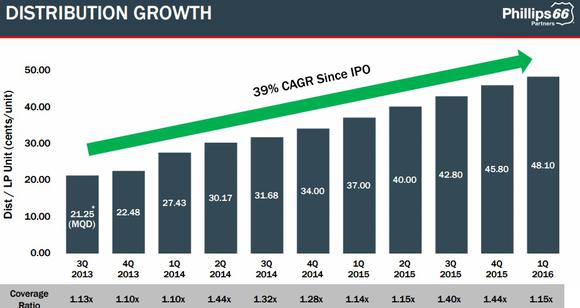
Source: Phillips 66 Partners
Since its IPO in late 2013 Phillips 66 Partners (NYSE: PSXP) has rewarded investors with performance that, despite falling 30% from its highs thanks to the oil crash, thumped both its MLP peers, as well as the overall market.
 PSXP Total Return Price data by YCharts
PSXP Total Return Price data by YCharts
With its latest earnings release Phillips 66 Partners reveals not only impressive growth in the face of extremely challenging conditions in the energy sector, but also several reasons that dividend investors can likely expect the rest of 2016 to be similarly rosy.
Oil crash hasn't halted growth in the slightest
| Metric | Q1 2016 | Q1 2015 | YOY Change |
| Revenue | $121.2 Million | $70.1 Million | 73% |
| EBITDA | $83.9 Million | $46.6 Million | 80% |
| Distributable Cash Flow (DCF) | $64.1 Million | $41.9 Million | 53% |
| Quarterly Distribution | $0.481 | $0.37 | 30% |
| Distribution Coverage Ratio (DCR) | 1.15 | 1.14 | 1% |
Phillips 66 Partners' latest results show no indications that the oil crash is harming its impressive growth efforts. That's especially true when it comes to the two metrics dividend growth investors care most about: the quarterly payout, and the coverage ratio that indicates good sustainability and little short-term risk of a distribution cut.
In fact, according to chairman and CEO Gregg Garland, “We remain on track to achieve our five-year annual distribution growth-rate objective of 30 percent through 2018."
The impressive growth was a result of the MLP's Q4 2015 acquisition of its sponsor and general partner Phillips 66's Sweeny fractionation and cavern storage assets.
More importantly, dividend growth investors have good reasons to remain optimistic about continuing sustainable payout growth and likely market beating returns for many years to come.
Payout profile remains as solid as ever BUT...
- Forward yield: 3.6%
- Trailing 12 Month DCR: 1.29
- Long-term payout growth forecast: 30%
Not only does Phillips 66 Partners offer a very respectable yield, but more importantly the MLP has a good track record of covering its payout with DCF that is locked in under long-term, fixed-fee contracts with Phillips 66, America's largest independent refiner. When oil prices crash refiners often see their margins expand, which explains why Phillips 66 Partners' hasn't fared as badly as many other MLPs.
As to the issue of growth, well its hard to find payout growth guidance better than what this MLP is offering. That being said, always remember that guidance is just a "best guestimate" and should never be relied upon as the cornerstone of one's investment thesis. Instead ask yourself "does this company's track record and realistic growth runway make such guidance reasonable?"

Source: Phillips 66 Partners' investor presentation.
In the case of Phillips 66 Partners the payout track record does indeed give credence to management's optimistic distribution growth guidance. Better yet management recently announced another major asset purchase that is likely to make 2016's DCF, and thus sustainable distribution growth, live up to investor expectations.
On May 4th management announced that it was buying the remaining 75% of the Sweeny Fractionator and cavern storage assets for $775 million. As part of the deal Phillips 66 Partners is also gaining the Standish pipeline, which transports refined NGL (natural gas liquids) from Phillips 66's Oklahoma refinery to its distribution facility in Wichita, Kansas.
More importantly for dividend investors Phillips 66 is dropping down these midstream assets with volume committed, fixed-fee 10 year contracts in place; thus ensuring continued DCF and payout growth no matter what energy prices do.
One big risk factor bears watching going forward
Of course no stock is without risk and in the case of Phillips 66 Partners that risk is too much debt.
| MLP | Total Debt | Debt/EBITDA (Leverage) Ratio | Average Interest Rate | Return on Invested Capital (ROIC) |
| Phillips 66 Partners | $1.303 Billion | 3.8 | 3.5% | 17.32% |
| Shell Midstream Partners | $458 Million | 2.0 | 1.7% | 59.63% |
| MPLX | $5.154 Billion | 4.3 | 1.6% | 2.62% |
| Valero Energy Partners | $546 Million | 2.9 | 1.5% | 15.29% |
High debt loads are to be expected in highly capital intensive industries such as this. However, as seen recently with highly leveraged midstream MLPs such as Kinder Morgan (NYSE: KMI) and Williams Partners (NYSE: WPZ), too much debt can cause immense trouble in the long-term.
Specifically Kinder Morgan's 2015 dividend cut was a result of credit rating agencies threatening to cut its rating to junk status. As for Williams Partners, it chose to maintain its payout and take the credit downgrade to junk, which will make rolling over its enormous debt load much more expensive in the future.
Don't get me wrong. Currently none of these fast growing, refiner sponsored midstream MLPs leverage ratio's are at the same dangerous level as Kinder's or Williams'.However Phillips 66 Partners' investors should keep a close eye on its leverage ratio to make sure that it doesn't get into a similar situation.
That's especially true considering that Phillips 66 Partners' debt costs are so much higher than competitors such as Shell Midstream Partners, (NYSE: SHLX), MPLX (NYSE: MPLX), and Valero Energy Partners (NYSE: VLP). Granted Phillips 66 Partners' ROIC is similar to Valero Energy Partners' and high enough to mean that management is still allocating investor capital wisely.
The same can't be said, at least not in the short-term, for MPLX's recent acquisition of MarkWest Energy Partners. That enormous, debt laden deal brought its ROIC below its weighted average cost of capital; a situation that is likely to last until natural gas prices recover.
Bottom line
After a great earnings report, and given its sponsor's giant drop down pipeline of midstream assets, strong coverage ratio, and solid returns on investor capital, it's earned a spot on your dividend growth watch list.
